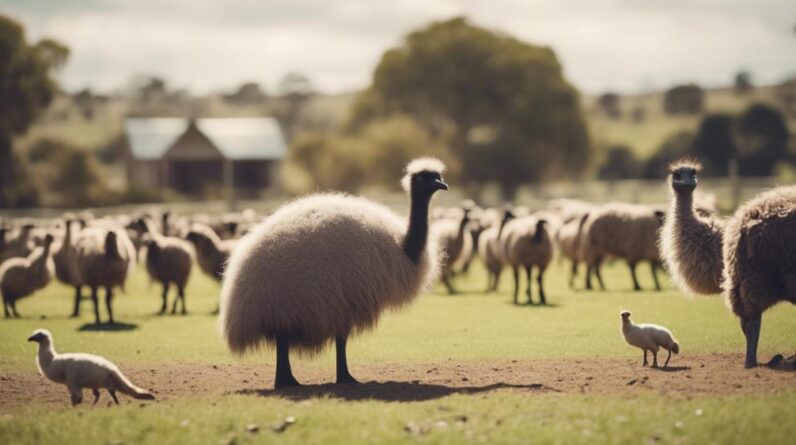
Have you ever considered the unique challenge of raising emus alongside your other livestock?
Emus can offer benefits like pest control and companionship, but there are also potential drawbacks to be aware of.
From their specialized diet to how they interact with other animals, navigating the world of mixed-species farming with emus involves a variety of factors to consider.
Understanding the pros and cons of this arrangement can help you make informed decisions for your farm's success.
Key Takeaways
- Emus provide protection, alertness, and predator deterrence for other livestock.
- Proper diet management and health monitoring are essential for emus' well-being.
- Careful introduction, monitoring flock dynamics, and separate enclosures are crucial for livestock compatibility.
- Understanding social dynamics, implementing rotation strategies, and ensuring harmony among animals optimize pasture management.
Emus' Unique Dietary Requirements
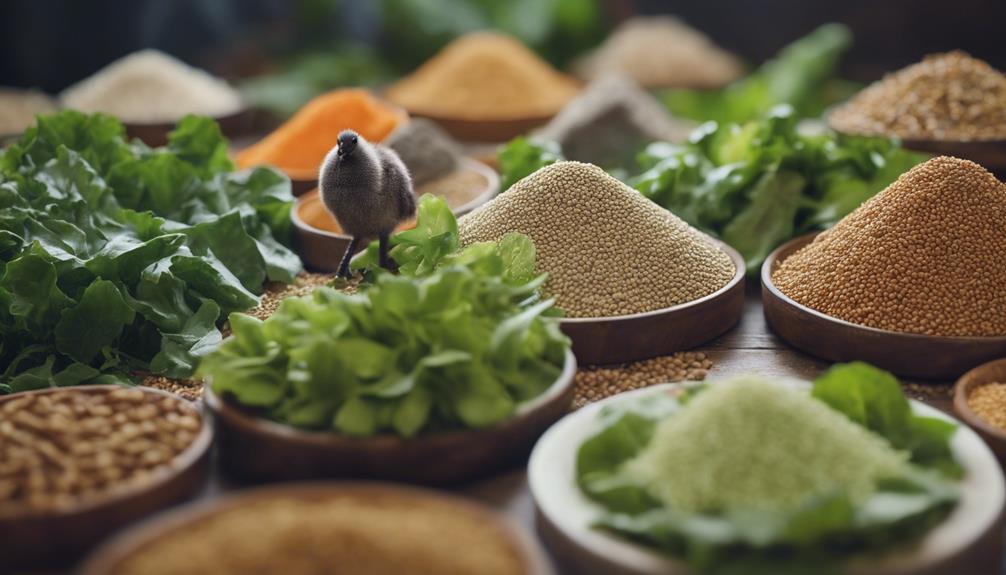
When raising emus alongside other livestock, understanding their unique dietary requirements is crucial for their health and overall well-being. Emus have distinctive feeding habits that set them apart from many other farm animals. These flightless birds are herbivores, primarily consuming a diet of plants, fruits, insects, and small vertebrates. It's essential to provide them with a balanced diet to ensure they receive all the necessary nutrients.
In addition to their regular diet, emus often benefit from nutritional supplements. These supplements can include vitamins and minerals that may be lacking in their primary food sources. Calcium supplements, for example, are crucial for maintaining strong bones and eggshell formation in breeding females.
Observing your emus' eating habits closely can help you determine if they need any additional supplements. Consulting with a veterinarian or an experienced emu farmer can also provide valuable insights into meeting these unique dietary requirements. By paying attention to their unique feeding habits and providing appropriate nutritional supplements, you can ensure your emus stay healthy and thrive alongside your other livestock.
Compatibility With Different Livestock
To evaluate the compatibility of emus with different livestock on your farm, consider their social behaviors and space requirements. Emus are generally peaceful animals but can be territorial, so observing flock dynamics is crucial when introducing them to other livestock. Their grazing habits also differ from traditional livestock, as emus are known to be selective grazers, preferring certain types of vegetation over others.
When considering compatibility with other livestock, regular health monitoring is essential. Emus have different susceptibility to certain diseases compared to other livestock, so being vigilant with health checks can help prevent any potential issues.
In terms of feeding routines, emus have specific dietary requirements that may not align with those of other livestock. Monitoring their food intake and ensuring they receive the necessary nutrients is vital for their health and well-being. By carefully managing flock dynamics, grazing habits, health monitoring, and feeding routines, you can successfully raise emus alongside other livestock on your farm.
Disease Transmission Risks
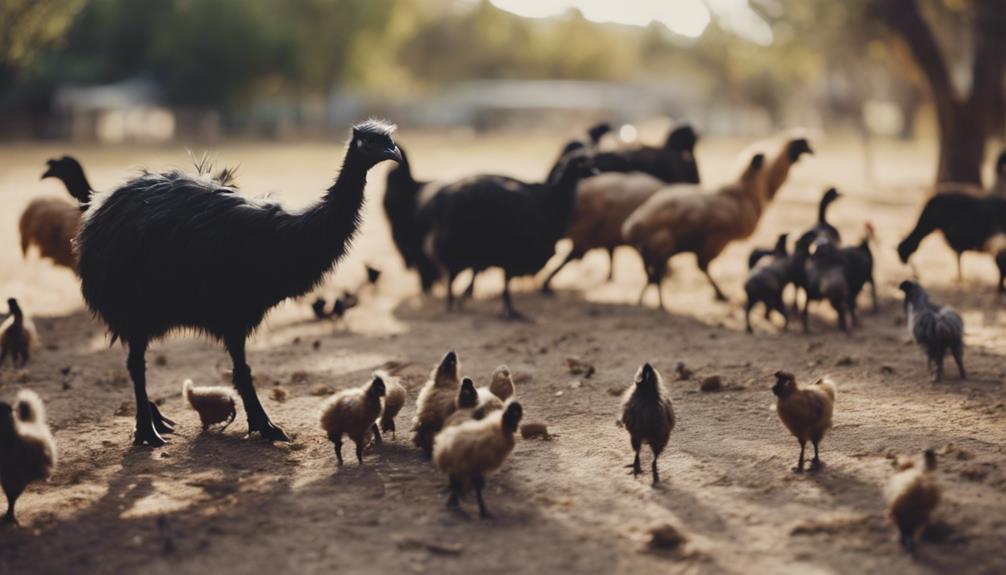
Considering the potential risks of disease transmission, it is crucial to understand how emus interact with other livestock on your farm. Emus can pose both benefits and risks when it comes to disease transmission. Implementing proper disease control measures and biosecurity protocols is essential to minimize these risks. Regular health monitoring of all animals, including emus, is crucial to detect any potential issues early on. Here is a table summarizing key points related to disease transmission risks when raising emus alongside other livestock:
| Aspect | Considerations |
|---|---|
| Disease control measures | Implement strict biosecurity protocols |
| Transmission prevention | Separate feeding areas to prevent direct contact |
| Health monitoring | Regular check-ups for all animals on the farm |
| Risk assessment | Evaluate the potential impact of diseases on all species |
Emus as Guardians for Other Animals
Emus can serve as vigilant protectors for other animals on your farm, showcasing their natural instinct for safeguarding the herd. Their behavior includes a keen awareness of their surroundings, which can help detect potential threats to the livestock they're guarding.
Here are some key points to consider regarding emus as guardians for other animals:
- Emu Behavior: Emus are naturally curious and territorial birds, making them alert to any unfamiliar presence around their territory. This behavior translates into a protective instinct that can benefit the safety of other animals on the farm.
- Protection Dynamics: When emus bond with other livestock, they establish a protective dynamic within the group. Emus can alert the herd of any danger, and their swift movements can deter predators from approaching, offering an added layer of security for the entire livestock population.
- Livestock Companionship: Emus often form bonds with other animals, creating a sense of companionship that strengthens the herd's unity. This companionship can lead to improved social interactions among different species, fostering a harmonious environment on the farm.
Space and Housing Considerations
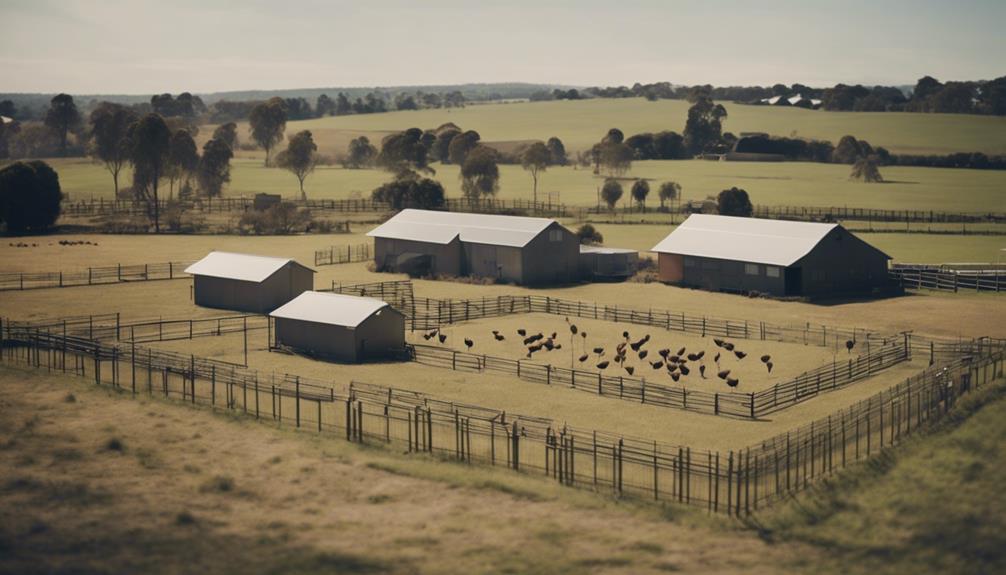
In planning your farm's layout, it is essential to carefully assess the space and housing requirements for emus and other livestock to ensure their well-being and safety. When considering shelter design, emus need structures that provide protection from extreme weather conditions and predators. Emus prefer open spaces to roam around, so their enclosures should allow for ample space. Utilizing the land efficiently is crucial to prevent overcrowding and potential conflicts among different species. Here is a table outlining key considerations for space and housing:
| Aspect | Emus | Other Livestock |
|---|---|---|
| Shelter Design | Enclosed shelters with tall openings to accommodate their height. | Separate housing for different species to prevent stress. |
| Space Requirements | Emus require large areas to move freely and exercise. | Livestock, like goats or sheep, need grazing space and sleeping areas. |
| Safety Measures | Fencing should be secure and tall to prevent escape. | Ensure fencing is appropriate for the size and behavior of each species. |
Potential Aggression Towards Other Livestock
When introducing emus to other livestock on your farm, it's crucial to carefully monitor and address any potential aggression that may arise. Emus can display territorial behavior, especially during mating season or when they feel threatened. Here are some key points to consider:
- Behavior Management: Emus are naturally curious and can sometimes exhibit aggressive behavior towards other livestock, particularly if they feel their territory is being invaded. It's essential to observe their interactions closely and intervene if necessary to prevent any harm.
- Training Techniques: Implementing proper training techniques can help minimize aggressive behavior in emus towards other livestock. Positive reinforcement methods, such as rewarding calm behavior and redirecting aggression, can be effective in shaping their interactions.
- Supervision: Regular supervision is crucial when emus are interacting with other livestock. Being present allows you to intervene quickly if any signs of aggression are displayed, ensuring the safety of all animals on your farm.
Benefits of Diversifying Livestock

Diversifying your livestock can offer numerous advantages for your farm's overall sustainability and resilience. By introducing a variety of animals, you not only spread out risks but also create opportunities to enhance your marketing strategies and profit margins. Here's a breakdown of the benefits of diversifying your livestock:
| Benefits of Diversifying Livestock | Description |
|---|---|
| Increased Market Opportunities | By having different types of livestock, you can cater to various market demands, potentially increasing your customer base. |
| Risk Mitigation | If one market experiences a downturn, having diversified livestock can help buffer against financial losses. |
| Improved Soil Fertility | Different animals contribute different nutrients to the soil through their waste, aiding in better soil health. |
| Enhanced Biodiversity | Having a variety of animals promotes biodiversity on your farm, creating a more resilient ecosystem. |
| Rotation Grazing Benefits | Grazing different types of livestock together can lead to better pasture management and increased productivity. |
Diversification not only adds depth to your farming operation but also opens up avenues for innovation and growth.
Breeding and Reproduction Challenges
Facing various challenges in breeding and reproduction can significantly impact the success of your livestock operation. When it comes to raising emus alongside other animals, it's essential to be aware of the specific breeding challenges and reproduction obstacles you may encounter.
Here are some key points to consider:
- Breeding Challenges
- Emus can be selective breeders, making it crucial to monitor mating behaviors and ensure successful pairings.
- Emus have a long reproductive cycle, with females laying eggs every 3-4 days during the breeding season, requiring dedicated monitoring.
- Emus are sensitive to changes in their environment, so providing a stable and stress-free breeding environment is essential for successful reproduction.
Understanding these breeding challenges and reproduction obstacles will help you navigate the complexities of raising emus alongside other livestock effectively. By being proactive and attentive to the needs of your emus, you can enhance the breeding and reproduction processes, ultimately contributing to the overall success of your livestock operation.
Emus' Impact on Pasture Management
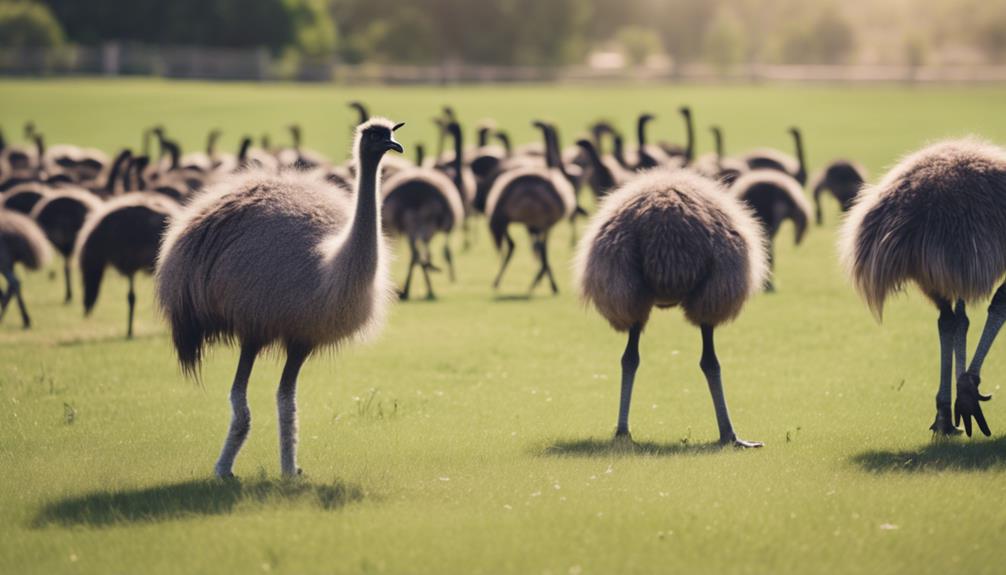
Emus can significantly influence pasture management practices due to their grazing habits and impact on vegetation. These unique birds have specific grazing patterns that can either benefit or challenge pasture health. Emus tend to prefer certain types of vegetation over others, which can lead to uneven grazing if not managed properly. This selective grazing behavior can impact the overall biodiversity of the pasture and may require careful monitoring to prevent overgrazing in certain areas.
In terms of soil health, emus' grazing habits can have both positive and negative effects. Their constant movement and grazing can help aerate the soil, promoting better water infiltration and nutrient absorption. However, if not managed correctly, their grazing can also lead to soil compaction in high-traffic areas.
To mitigate these effects, implementing rotation strategies is essential. Rotating emus with other livestock or moving them to different pastures periodically can help prevent overgrazing, promote pasture rejuvenation, and maintain overall soil health. By carefully planning grazing rotations, you can optimize pasture management practices and ensure the long-term sustainability of your land.
Economics of Raising Emus With Other Livestock
Considering the interplay between pasture management and livestock economics, understanding the financial implications of incorporating emus alongside other livestock is crucial for sustainable farming practices. When evaluating the economics of raising emus with other livestock, two key factors come into play:
- Cost Efficiency: Emus can be cost-effective to raise due to their low maintenance requirements and efficient feed conversion rates. However, initial setup costs for emu enclosures and specialized equipment should be taken into account.
- Market Demand: Before integrating emus with other livestock, researching market demand for emu products is essential. Understanding current trends and consumer preferences can help maximize profits and ensure a steady income stream.
- Profit Potential: Assessing the potential profitability of raising emus alongside other livestock involves calculating overhead costs, anticipated revenue from product sales, and the overall return on investment. Striking a balance between costs and profits is key to a successful mixed livestock operation.
Handling and Safety Concerns
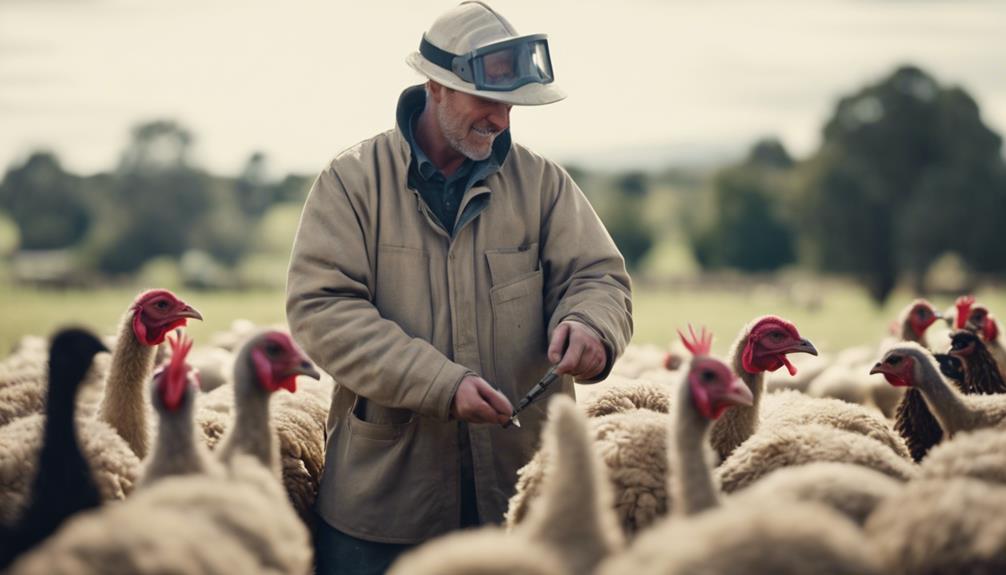
To ensure successful integration of emus with other livestock on your farm, prioritizing proper handling and safety protocols is paramount. Safety protocols are crucial when handling emus due to their size, speed, and strong legs.
When working with emus, always approach them calmly and confidently to establish trust. Utilize training techniques such as positive reinforcement to encourage desired behaviors and discourage aggression. Emus can kick forcefully, so be cautious around them, especially during breeding season when they're more territorial.
Ensure that all fences and enclosures are secure and tall enough to prevent emus from escaping or causing harm to themselves or other animals. Regularly inspect and maintain all equipment used for handling emus to minimize risks.
Emus' Social Behavior Amongst Other Animals
Regularly observe and document the interactions between emus and other animals to gain insight into their social behavior dynamics. Emus exhibit intriguing social dynamics when integrated with different livestock species. Here are some key points to consider:
- Emus often establish a pecking order within the group, which can impact their interactions with other animals.
- Emus may display territorial behavior, especially during breeding seasons, which could influence how they coexist with other livestock.
- Integration strategies such as providing ample space for each species to roam freely and ensuring access to separate feeding areas can help minimize conflicts and promote harmonious relationships among emus and other animals.
Understanding the social dynamics of emus when raised alongside other livestock is essential for creating a peaceful and conducive environment for all animals involved. By implementing effective integration strategies, you can foster a cooperative and mutually beneficial relationship among emus and other livestock on your farm.
Frequently Asked Questions
Are Emus Territorial Animals and How Does This Affect Their Ability to Live Alongside Other Livestock?
Emus are territorial creatures, which can impact their ability to coexist with other livestock. Understanding emus' behavior and how it interacts with other animals is crucial for successful management when raising them alongside other livestock.
How Do Emus Compare to Other Livestock in Terms of Susceptibility to Common Diseases and Parasites?
Compared to other livestock, emus exhibit strong disease resistance but are susceptible to certain parasites. Their robust immune system acts as a shield, yet vigilance is crucial to prevent potential parasitic challenges in their environment.
Can Emus Effectively Protect Other Animals From Predators, and What Are the Limitations of Using Them as Guardians?
When considering emus as guardians for livestock, remember their innate predator-prey dynamics. Emus can offer protection, but limitations exist. They may not effectively deter all predators, especially those adept at circumventing their defenses.
What Are Some Potential Challenges in Integrating Emus With Different Livestock Species in Terms of Space and Housing Requirements?
In juggling different livestock, you'll hit snags with space constraints. Emus need room to roam. Housing challenges arise when blending them with other animals. It's like fitting puzzle pieces – challenging but rewarding.
How Do the Economics of Raising Emus Alongside Other Livestock Compare to Solely Focusing on One Type of Livestock?
When considering the economics of raising emus alongside other livestock, it's crucial to analyze the territory dynamics and potential benefits. Economic comparison shows that diversifying can offer stability and varied income sources, but requires thoughtful planning.
Conclusion
In conclusion, raising emus alongside other livestock can be a challenging endeavor.
While emus have unique dietary requirements and can serve as guardians for other animals, there are potential risks of disease transmission and safety concerns to consider.
Their impact on pasture management and social behavior among other animals should also be taken into account.
Balancing the pros and cons of integrating emus into your livestock operation is like walking a tightrope, requiring careful navigation and balance.





